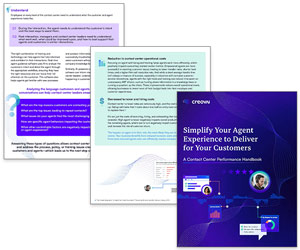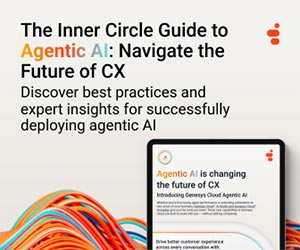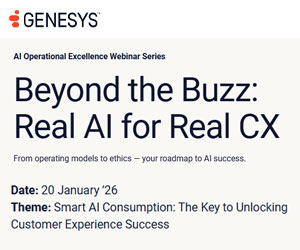AI is fast changing life in the contact centre – from handling simple queries to making after-call work a breeze. But what does all this mean for frontline agents?
Here, Mike Aoki and Pier Ragone take a closer look at what’s happening with talk time and after-call work right now and how contact centres should embrace this new era of complexity.
Talk Time Is Going Up and After-Call Work Is Going Down
With AI and self-service now handling straightforward customer interactions, such as password resets, order updates, and basic FAQs, contact centres are entering a new era. What is left for human agents are more emotional and complex enquiries.
This transition means two things can be true at once:
- Talk time will go up.
- After-call work may go down.
Why? Because AI can handle many Tier 1 interactions. That leaves Tier 2-level issues for frontline agents. These require active listening, empathy, and creative problem-solving. They also tend to take longer.
At the same time, AI-powered agent-assist tools can reduce after-call work by generating call summaries, follow-up emails, or callback reminders.
Talk time increases, post-call work decreases, and Average Handling Time (AHT) shifts in a way that reflects smarter operations, not failure.
Leaders focused strictly on efficiency might see rising talk time as a red flag. But what they’re actually seeing is AI doing its job.
The goal isn’t shorter talk time. The goal is solving the problem. A longer call that resolves the issue on the first try is worth far more than a quick one that leads to another contact.
If you are looking to work out how many contacts are resolved first time, read our article: What Is First Contact Resolution? – With Formula and Expert Best Practices
When Volume Was High, Shorter Calls Were the Priority
For years, contact centres have been measured by how fast they can move. Shorter calls, quicker resolutions, and lower costs were the priority. When volume was high and automation was limited, the maths worked. Get customers in and out as efficiently as possible.
But that era is long gone. AI and self-service now handle the basics. In some cases, they are solving issues that once required human logic and judgement.
So, what is left for human agents? The conversations that are complex, emotional, and often unclear. The ones where customers do not even know how to ask the question, and where the solution is not obvious.
That is why you should want talk time to go up. Not because you want inefficiency. But because if all the easy stuff is gone, then every live interaction should be something unexpected.
Something messy. Something meaningful. When the work changes, the job changes. Pretending it has not is where most organizations go wrong.
For advice on how video chat could be used to handle the complex and emotional conversations agents now face, read our article: Why Is Video Chat Being Underutilized?
We Are Asking Tier 1 Agents to Be Tier 2 Agents. That Changes Everything.
With routine tasks eliminated, the only issues reaching a human are doing so for a reason. The customer has tried self-service and chat support. They are stuck.
Whether it is a real issue or a perceived one does not matter. They need help. And now your frontline team need to step in to provide support and protect the brand.
We are asking Tier 1 agents to handle Tier 2 problems. That changes everything.
You cannot train someone for three weeks and expect mastery. You cannot offer entry-level pay and expect expert-level performance. You cannot isolate the contact centre and then question why outcomes fall short.
This is not a small adjustment. It requires a full rethinking of how you hire, how you train, how you pay, and how you position the role inside the organization.
So how do you do it?
6 Steps to Embracing Complexity in the Contact Centre
1. Rethink What Success Looks Like
Let go of the obsession with Average Handle Time (AHT) and raw efficiency. Fast does not always mean better.
Focus on metrics that reflect quality:
- First Contact Resolution (FCR)
- Customer Effort Score (CES)
- Customer Satisfaction Scores (CSAT)
- Resolution accuracy and depth
One longer call that truly solves the issue is worth more than three short ones that do not.
2. Develop Emotional Intelligence as a Core Skill
Product knowledge and policy training are not enough any more.
The modern agent needs to:
- Ask better questions
- Listen with empathy and without interrupting
- Manage their own emotions while staying grounded
- Reframe problems in a way that empowers the customer
- Use critical thinking skills to solve complex problems
This is the work now. Not just process, but presence.
Since AI is handling straightforward interactions, human agents need emotional intelligence and critical thinking skills to handle the remaining emotionally and mentally complex issues.
3. Teach the Right Call Flow (Listen, Teach, Solve)
Forget jargon. Drop the acronyms.
Teach people how to:
- Truly listen. Make the customer feel heard. They have already tried everything else.
- Teach something. Share knowledge in a way that is actually useful.
- Solve the issue. Fully, not halfway.
Simple in theory. Rare in execution. Doing this well takes practice, coaching, and leadership that models it.
4. Treat Complex Calls as Intelligence, Not Inconvenience
Every confusing or emotional call tells you something:
- Where friction exists in your product
- What processes are failing customers
- What your chatbot still cannot handle
Do not just resolve it and move on. Track it. Analyse it. Feed it back into the business. The contact centre is your early warning system if you are willing to listen.
Whether it is Voice of the Customer or Voice of the Employee programmes, treat your contact centre as the intelligence gathering operation it is.
The more you know, the more you can improve customer retention and develop new products and services to meet their needs (and that means more revenue too!).
5. Support Agents With Tools and Autonomy
As complexity rises, so should support:
- Real-time access to accurate knowledge
- Clear escalation paths that do not require begging for help
- Trust to make decisions within smart boundaries
Use AI agent-assist tools not to replace humans but to support them. These tools can automate post-call summaries, recommend next steps, and lighten after-call workload. That frees agents to focus on delivering real value.
Talk time may rise, but after-call work time may shrink. Agents have tools to help them solve problems. Customers receive helpful human support. And the contact centre improves First Contact Resolution (FCR) without sending AHT through the roof.
6. The Human Connection Remains Critical and Should Not Be Rushed
Different customers prefer different service channels. Some prefer phone. Others prefer chat, SMS, or self-service. Let your customers choose how they want to reach you.
For some, especially seniors, live phone support is not just preferred. It is required for trust and clarity. Not everyone wants to interact with AI, no matter how advanced it is.
This human connection remains essential. It may affect the volume and length of your calls. That is OK. Let conversations take the time they need to solve the problem the first time.
For examples of how to blend human agents and AI to deliver exceptional customer experiences, read our article: The Superhuman Touch – How to Blend Agents and AI for Maximum Impact
Let the Easy Stuff Go and Prove Your Value
With the easy stuff gone, what is left is where the real work begins. The human stuff. The emotional stuff. The problems that do not have dropdown options.
So yes, you want your talk time to go up. Because if you are going to invest in people, then let them do the work only people can do. This is not a stepping stone. It is not an afterthought. It is a critical role that demands intelligence, empathy, and strategic investment.
Let the easy stuff go. What is left is where we prove our value.
Written by: Mike Aoki and Pier Ragone
If you are looking for more advice that could help you improve your customer service, read these articles next:
- Are Your Team Leaders Too Busy Chasing Metrics?
- Top Tactics to Improve First Contact Resolution (FCR)
- 15 Proven Tactics to Reduce Abandon Rate
Author: Megan Jones
Reviewed by: Jo Robinson
Published On: 29th Jul 2025 - Last modified: 15th Sep 2025
Read more about - Call Centre Management, After Call Work (ACW), Average Handling Time (AHT), Call Handling, Customer Experience (CX), Customer Service, Management Strategies, Mike Aoki, Pier Ragone, Top Story









































